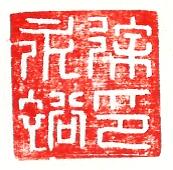Seal (emblem)
Device used to authenticate documents
A seal is an emblem used to authenticate documents, often in the form of a stamp or an impression made on wax, paper, or other materials. Seals have been used for centuries to signify the authenticity and integrity of documents, and they continue to be used in various forms today.
History[edit | edit source]
Seals have a long history, dating back to ancient civilizations such as Ancient Egypt, Mesopotamia, and Ancient China. In these cultures, seals were often made from materials like stone, metal, or clay and were used to mark ownership, authority, and authenticity.
Ancient Egypt[edit | edit source]
In Ancient Egypt, seals were commonly used by officials and royalty. The seals often featured hieroglyphs and were used to secure tombs, mark property, and authenticate documents.
Mesopotamia[edit | edit source]
In Mesopotamia, cylinder seals were prevalent. These cylindrical objects were engraved with intricate designs and rolled over clay tablets to create an impression. They were used for administrative and commercial purposes.
Ancient China[edit | edit source]
In Ancient China, seals were known as "chops" and were used by emperors, officials, and scholars. These seals were typically made from jade, ivory, or metal and were used to authenticate documents and artworks.
Types of Seals[edit | edit source]
Seals can be categorized into several types based on their form and function:
Stamp Seals[edit | edit source]
Stamp seals are flat objects with an engraved design that is pressed onto a surface to create an impression. These are commonly used for official documents and letters.
Cylinder Seals[edit | edit source]
Cylinder seals are cylindrical objects with an engraved design that is rolled over a surface to create a continuous impression. These were commonly used in ancient Mesopotamia.
Signet Rings[edit | edit source]
Signet rings are rings with an engraved seal that can be used to stamp an impression. These were often used by nobility and officials to sign documents.
Wax Seals[edit | edit source]
Wax seals involve melting wax and pressing a seal into it to create an impression. These were commonly used in medieval Europe to secure letters and documents.
Modern Use[edit | edit source]
Today, seals are still used in various forms, including rubber stamps, embossed seals, and digital seals. They are used by governments, corporations, and individuals to authenticate documents and signify approval.
Related Pages[edit | edit source]
Search WikiMD
Ad.Tired of being Overweight? Try W8MD's physician weight loss program.
Semaglutide (Ozempic / Wegovy and Tirzepatide (Mounjaro / Zepbound) available.
Advertise on WikiMD
|
WikiMD's Wellness Encyclopedia |
| Let Food Be Thy Medicine Medicine Thy Food - Hippocrates |
Translate this page: - East Asian
中文,
日本,
한국어,
South Asian
हिन्दी,
தமிழ்,
తెలుగు,
Urdu,
ಕನ್ನಡ,
Southeast Asian
Indonesian,
Vietnamese,
Thai,
မြန်မာဘာသာ,
বাংলা
European
español,
Deutsch,
français,
Greek,
português do Brasil,
polski,
română,
русский,
Nederlands,
norsk,
svenska,
suomi,
Italian
Middle Eastern & African
عربى,
Turkish,
Persian,
Hebrew,
Afrikaans,
isiZulu,
Kiswahili,
Other
Bulgarian,
Hungarian,
Czech,
Swedish,
മലയാളം,
मराठी,
ਪੰਜਾਬੀ,
ગુજરાતી,
Portuguese,
Ukrainian
Medical Disclaimer: WikiMD is not a substitute for professional medical advice. The information on WikiMD is provided as an information resource only, may be incorrect, outdated or misleading, and is not to be used or relied on for any diagnostic or treatment purposes. Please consult your health care provider before making any healthcare decisions or for guidance about a specific medical condition. WikiMD expressly disclaims responsibility, and shall have no liability, for any damages, loss, injury, or liability whatsoever suffered as a result of your reliance on the information contained in this site. By visiting this site you agree to the foregoing terms and conditions, which may from time to time be changed or supplemented by WikiMD. If you do not agree to the foregoing terms and conditions, you should not enter or use this site. See full disclaimer.
Credits:Most images are courtesy of Wikimedia commons, and templates Wikipedia, licensed under CC BY SA or similar.
Contributors: Prab R. Tumpati, MD







